DNR oversees dozens of controlled fires annually to manage Maryland woodland areas
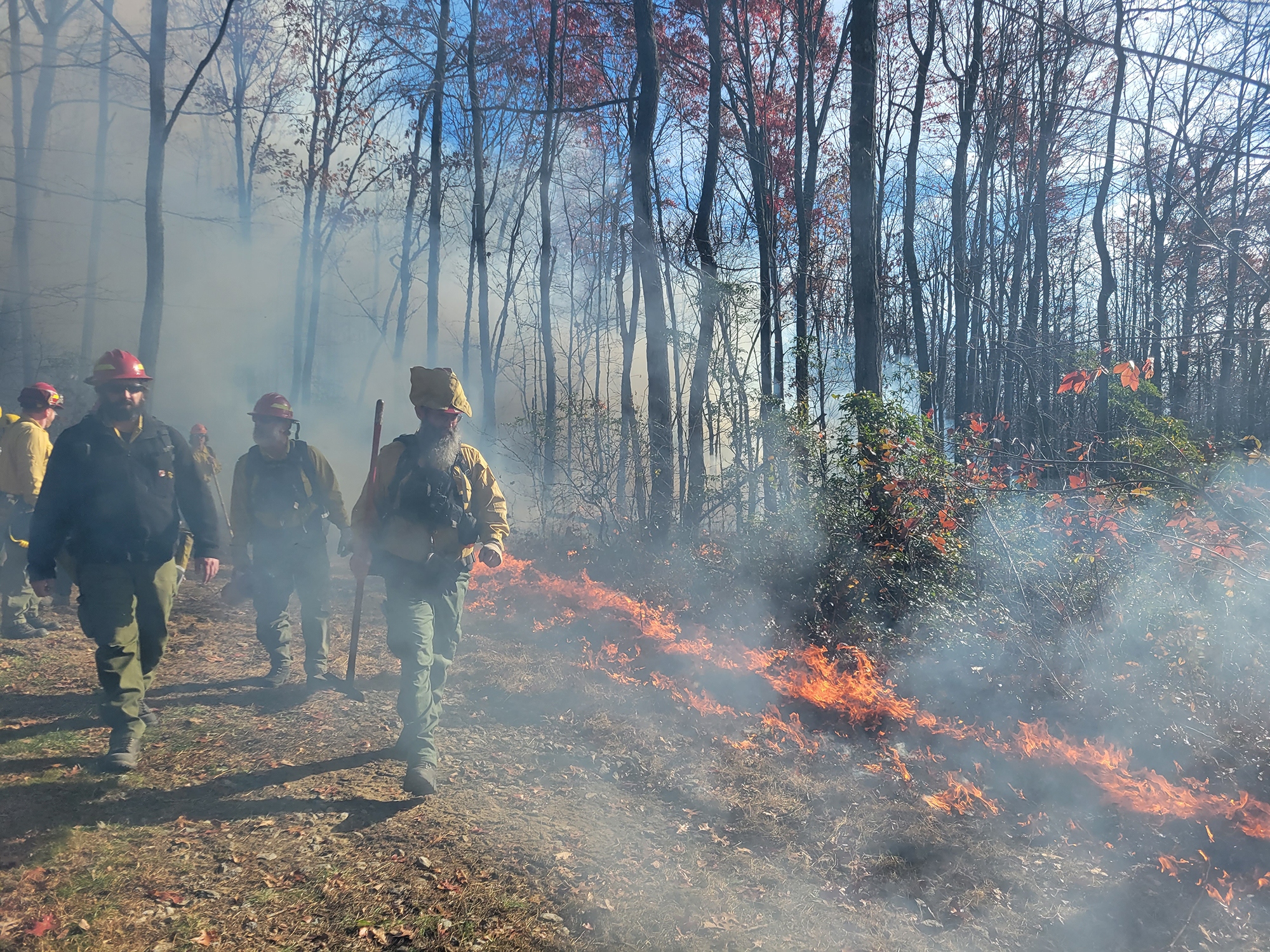
DNR forester Sean Weaver, left, walks along the fireline shortly after the start of a prescribed burn in Frederick. Photo by Joe Zimmermann
It was a chilly morning in the Frederick Watershed and the woods were quiet and peaceful. Without the sound of even a passing bird, a stillness filled the air between the nearly bare trees.
But at the intersection of two rocky roads deep in the watershed, there was a growing commotion. Red hats, yellow vests, and blue suits appeared through the vegetation. A fleet of pickups and fuel trucks and UTVs lined the forest edge. Dozens of people were gathering and prepping equipment for the day. They were about to set the woods on fire.
“We’re going to keep this briefing quick so we can bump up that hill,” Sean Weaver, a Maryland Department of Natural Resources forester for the watershed, told the assembled crowd at an 8 a.m. huddle.
Weaver was overseeing the day’s prescribed burn of a 93-acre stretch of the watershed known as the “Turkey Pens.” The fire, a result of meticulous planning and coordination, aimed at restoring pitch pine and oak trees in the forest.
The substantial crew comprised DNR staff from the Maryland Forest Service, Maryland Park Service, and Wildlife and Heritage Service, as well as partners from the National Park Service and Frederick City, and environmental science students from Juniata College in Pennsylvania. They readied to break off into teams that would tackle different sections of the Turkey Pens, filing back and forth along the edges until the separate lines would converge.
“We’re all going to be one big dysfunctional family,” joked Aaron Cook of the Forest Service and the burn’s ignition boss.

Forester Aaron Cook conducts an early morning briefing for the assembled team. Photo by Joe Zimmermann

The last of the fire crew walks up the hill in the calm of the Frederick Watershed just before the burn begins. Photo by Joe Zimmermann
After ascending the hill and setting a test fire to confirm conditions were right, the crew got to work. Many carried drip torches—canisters filled with a 3:2 mixture of diesel and gas—and drizzled the burning fuel along the ground, tipping them like infernal watering cans. Before long, the woods were crackling.
“Certain trees are on the decline here, and are being replaced, partly because of the lack of fire,” said Jenny Willoughby, the City of Frederick’s sustainability manager, as she walked the fire line. “It’s probably been about 100 years since this area has seen a big burn, and since that point, whenever an oak dies, a maple, a birch or a gum is going to take its place.”
In part, the prescribed burn serves as a corrective to that process. By removing a good portion of the duff—the leaf litter and organic matter that make up the forest floor—and clearing out many of the maple, gum and birch saplings, the fire gives species like pine and oak a chance to prosper. These trees are fire-resistant and come back faster in the bare mineral soil the flames leave behind.

Foresters hold drip torches, which spill lighted fuel onto the forest floor. Photo by Joe Zimmermann
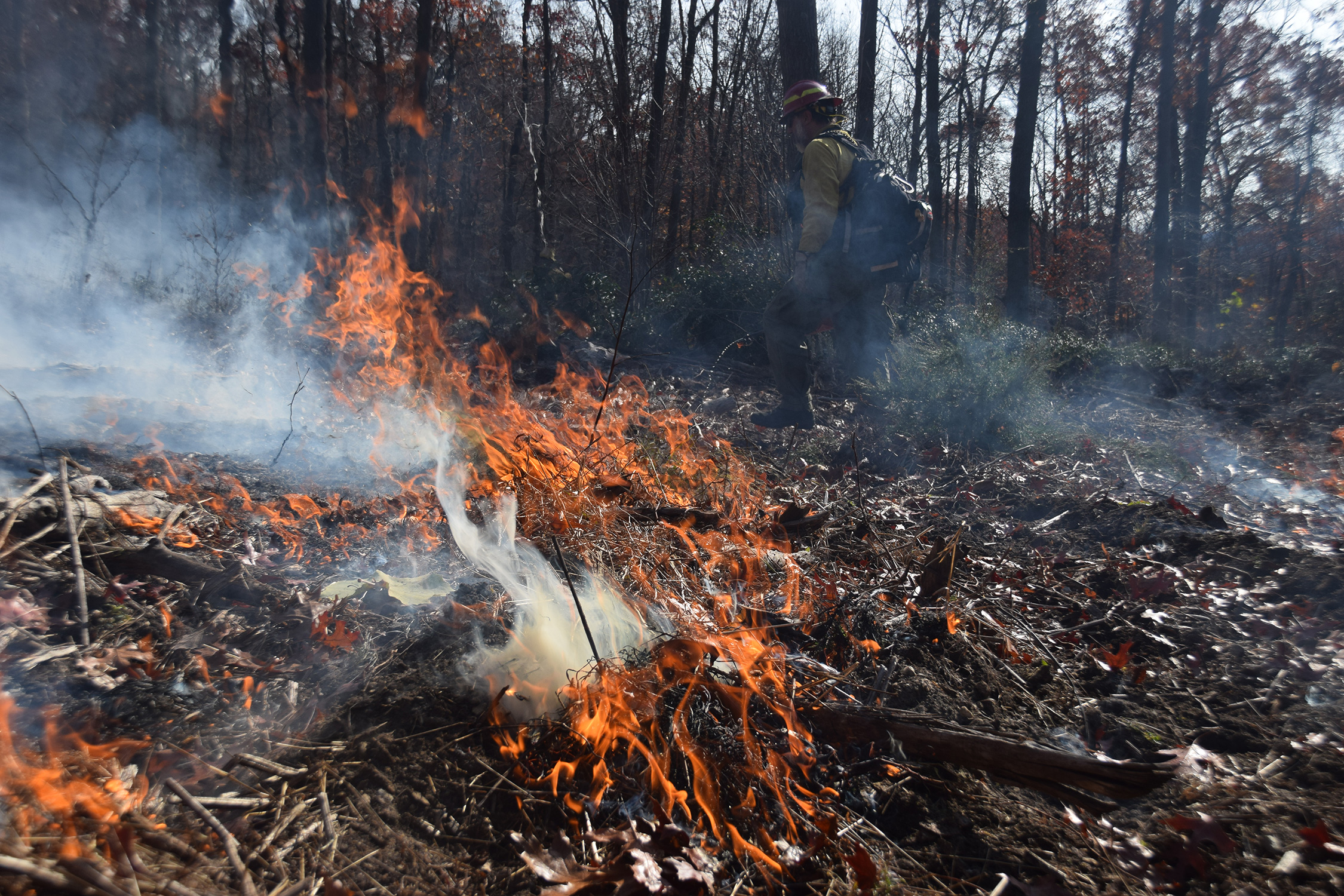
Low-level fires like the one in Frederick will eat through the duff–the layer of leaf litter–and burn off woody debris. Photo by Joe Zimmermann
The new tree growth should also help keep the soil intact and prevent sediment from building up in streams and groundwater, which in turn protects the nearby reservoir that provides Frederick with 20% of its water supply. Wildlife stand to benefit as well: as a mast species, oaks produce nuts that sustain more animals.
The low-intensity fire swept through the underbrush, with enough heat to kill saplings but still keep mature trees intact. The human noise tends to drive away most animals before the fire even begins, but the blaze is low enough that squirrels, snakes and other wildlife can sit it out safely in underground burrows, Willoughby said. During the late November burn, no animals emerged, except for one confused deer that ran through the area late in the day, and quickly moved on.
Prescribed burns, also called controlled burns, have become an increasingly common strategy for land management and wildfire prevention. Large wildfires are not as much of a concern in Maryland as they are in western states, but the prescribed burns conducted here still reduce the dead woody debris and shrub layer that could serve as fuel for unintended fires.
North America has a long history of prescribed burns, which were an indigenous practice for land management for thousands of years. Later, the United States Forest Service took a more active role in fire suppression. Now that controlled burns are becoming more accepted as a management tool, scientists say this is something of a return to how American forests once were.
“We’ve excluded fire from the landscape for decades now,” said Jason Harrison, a restoration ecologist with the Maryland Department of Natural Resources. “When we return fire to the landscape, we bring back that natural disturbance to the land.”
Many species benefit from fire. The pinecones of pitch pine open in high temperatures, allowing them to disperse seeds. Some endangered species rely on fire as well, such as the sundial lupine, a fire-adaptive flowering plant that’s threatened in Maryland and serves as a host species to the globally rare frosted elfin butterfly. Fires on the Eastern Shore open up areas that the plant and the butterfly need to thrive, Harrison said.
“A number of rare species need open, sandy soil—the only way to get to that is to burn it,” Harrison said, noting the striking effects fires have on reducing shade-tolerant vegetation and clearing the land for new life. “The following spring can be eye opening, you see this pulse of vegetation that wasn’t there before, where it was only pine needles.”
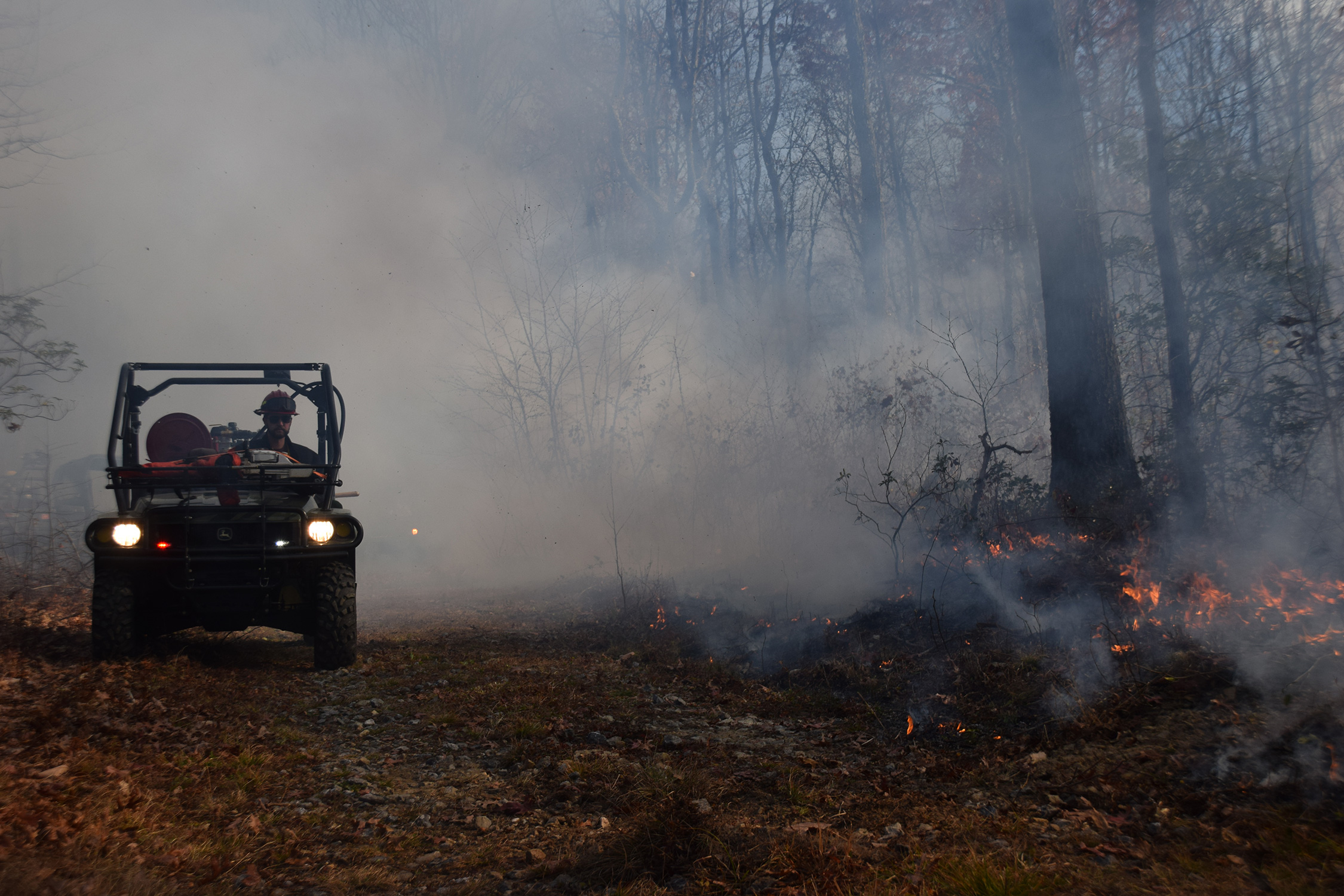
A UTV drives down the former logging road that borders the Turkey Pens area. Photo by Joe Zimmermann
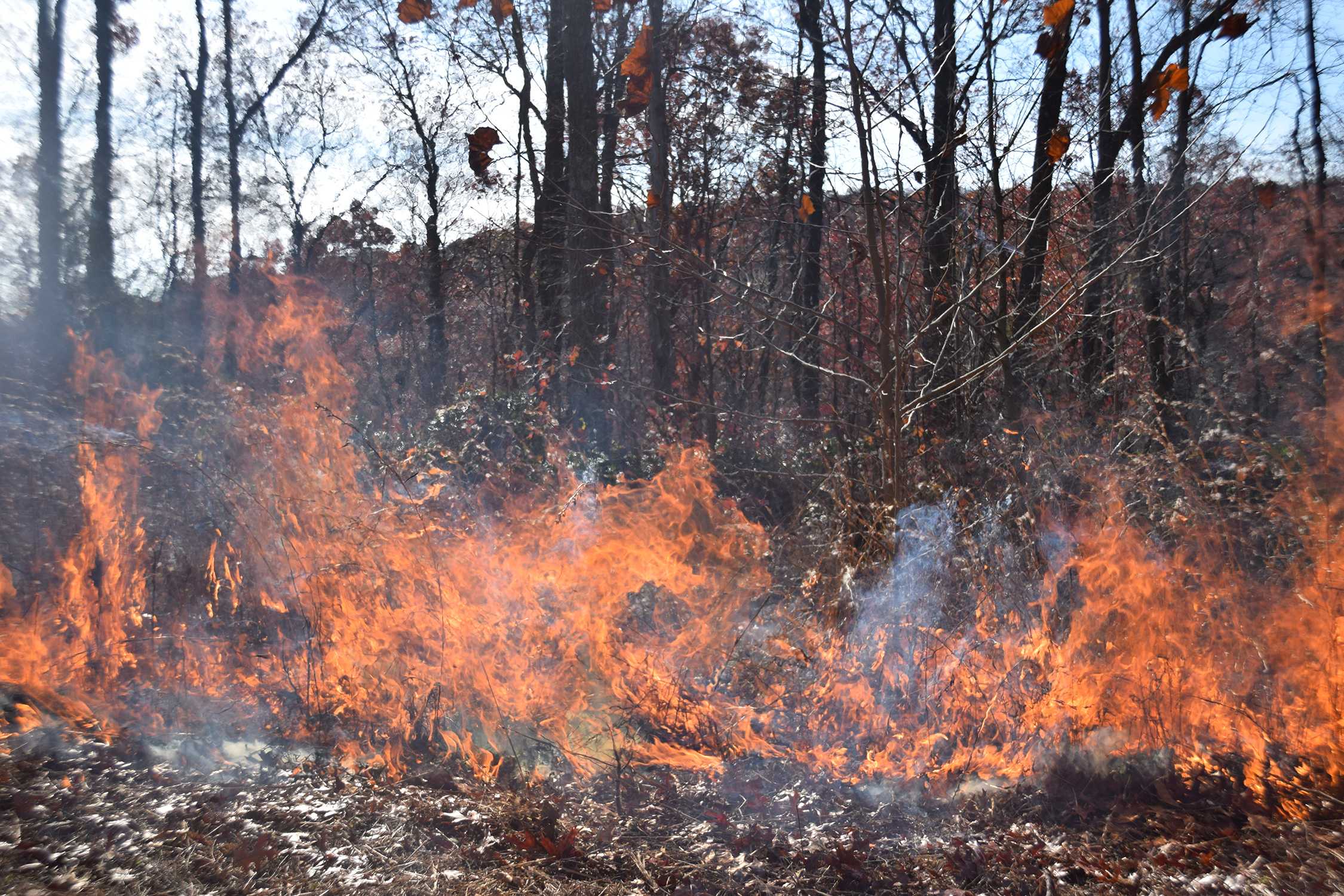
The fire sometimes becomes larger as it picks up more fuels. Laurels burn quick and hot. Photo by Joe Zimmermann
In 2023, there were 109 prescribed burns in Maryland conducted by DNR, private landowners and groups like the Nature Conservancy, said Chris Robertson, Maryland Forest Service state fire supervisor. Just over 9,000 acres were burned. That’s a slight increase over past years, and Robertson said the number is likely to continue to go up as the practice becomes more popular.
“It’s being talked about more and more,” he said. “We’ve found that it’s a good management tool and we’re promoting it more than in the past.”
Burns are most common in the early spring. This avoids the late spring when birds are nesting and bats are roosting, as well as the hotter months of the summer, Robertson said.
While there are more burns on the Eastern Shore and in western Maryland, they occur throughout the state, for a variety of reasons, from warm season grass burns to understory management. Robertson said hunters and trappers have found that fires are a good way to create habitats for turkeys, bobwhite quails, and other game animals.
Whatever the goal, every prescribed burn has a specific purpose—and requires a permit. Private residents can conduct a burn only if they have the necessary wildland fire training, or they can turn to DNR, which provides a paid service to conduct burns on private land, Robertson said.
Safety is always a top priority. At the Frederick Watershed burn, crews created fire lines using the forest roads and an old logging trail, anything to serve as a break, Weaver said. They monitored the edges, and if the flames got close to crossing the line, personnel would be ready to rake the ground and extinguish the spread. In addition to the water tanks on the UTVs, there was a water truck at the base of the hill and a pump to fill from the creek if needed.
The teams stayed in constant communication throughout the day, arcing through the woods until they slowly converged. With a drone that captured visual and thermal images, the Maryland Forest Service watched for smoke—another key consideration at these burns—and monitored the paths of fire as the teams came closer together along the edges of the Turkey Pens.

The Maryland Forest Service uses a drone to monitor the spread of smoke and the progression of the burn, checking for hot spots and problem areas. Photo by Melissa Nash, DNR

A thermal image overlaid over an aerial photo shows the area with active fire. Teams work in lines that cut across the burn area, slowly coming together. Photo by Melissa Nash, DNR

Aside from drip torches, other tools allow the crew to light up harder to reach areas. The PyroShot pellet gun injects a ball of potassium permanganate, a “dragon egg,” with antifreeze, then launches the ball up to a football field’s length away. The operator has about 20 seconds before the chemical reaction ignites. Photo by Joe Zimmermann
By mid-afternoon, most of the Pens was burned through. The smoke appeared as a brown haze among the trees, and the crackling of burning wood was so constant that it sounded like the patter of rain.
Most of the crew had cleared out and headed home by 5 p.m., though a small group remained into the night. Weaver and his technician stayed until 1 a.m. to keep an eye on the flames.
The wind cooperated—staying low and not spreading smoke—but the rain did not. The expected showers didn’t arrive until the next week, which necessitated several more days of monitoring while the embers still smoldered. Weaver stayed positive though, and pointed out how the longer-than-expected burn ate away at more of the duff.
He knew it would be an ongoing process to manage the Frederick Watershed, but he was excited to see the results of the fire.
“Springtime is when we’ll get the best sense of what we’ve accomplished,” he said, days later and ready to take a break from the burn. “We expect to see pitch pine seedlings sprouting up. Right in that area we expect to see pitch pine seedlings start to take root.”
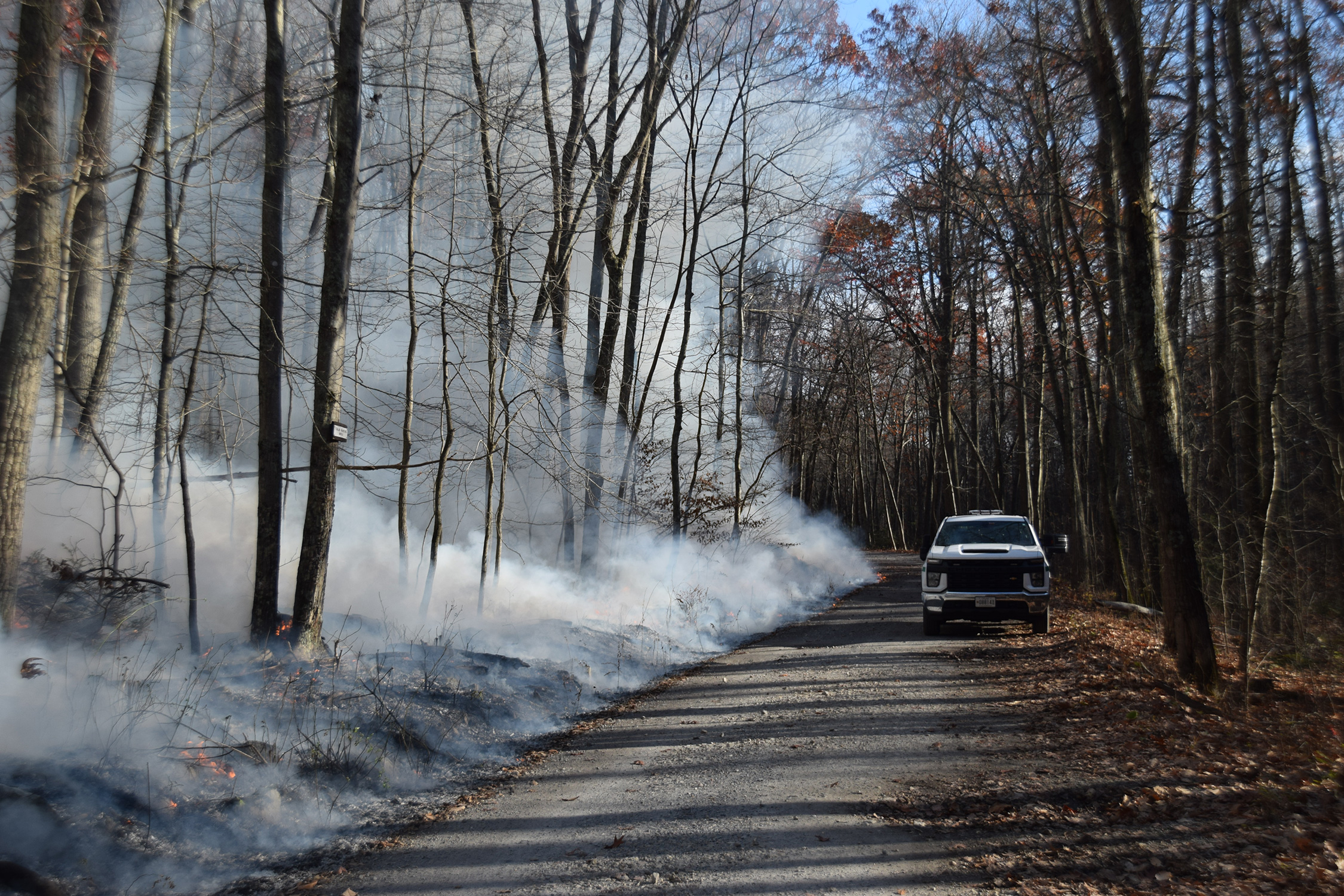
Roads serve as a good fireline–a break in fuel that stops the burn from spreading further. Photo by Joe Zimmermann
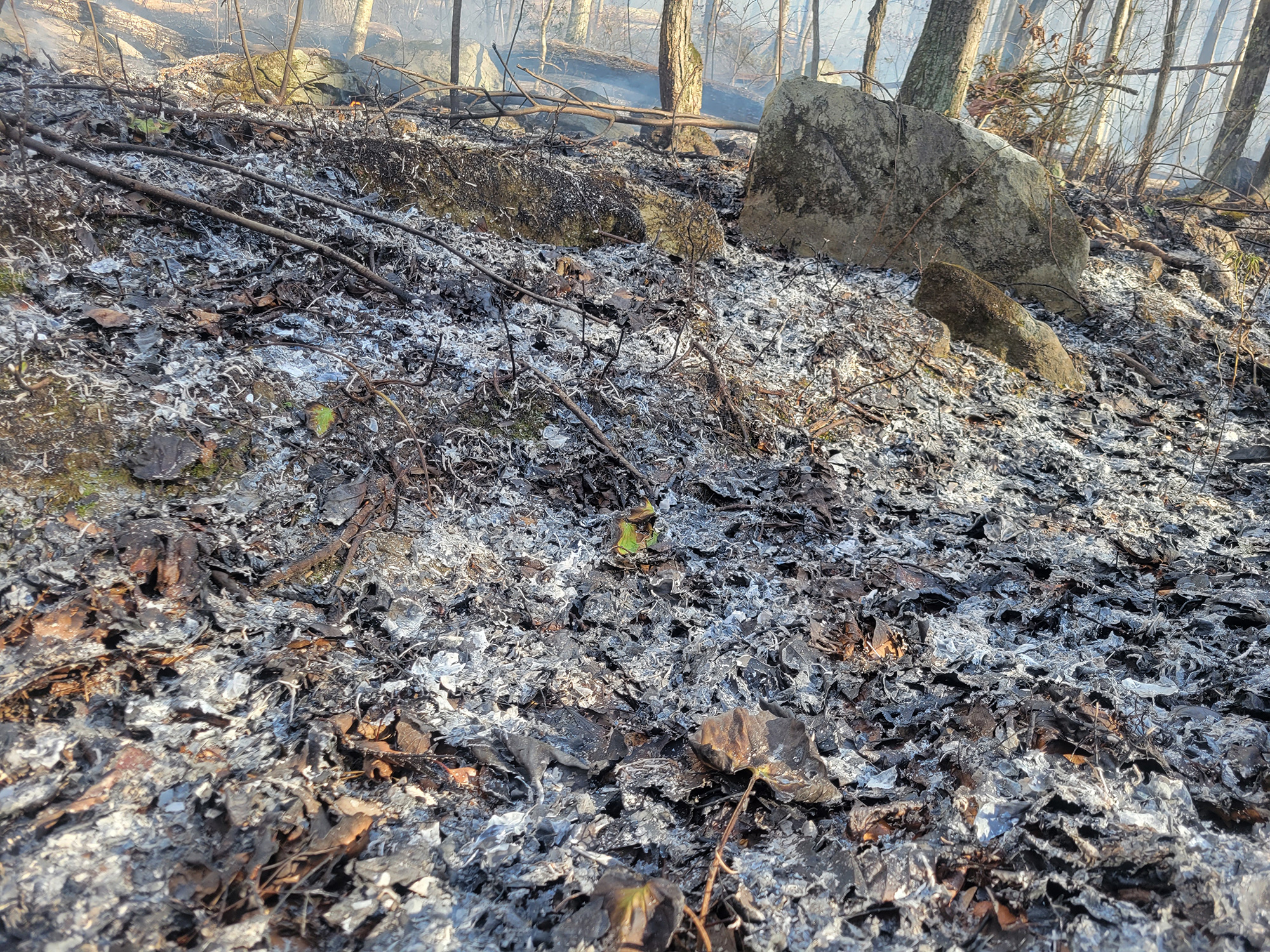
The forest floor is transformed after the fire, creating conditions that will support new pitch pines and oak. Photo by Joe Zimmermann
By Joe Zimmermann, science writer with the Maryland Department of Natural Resources.
